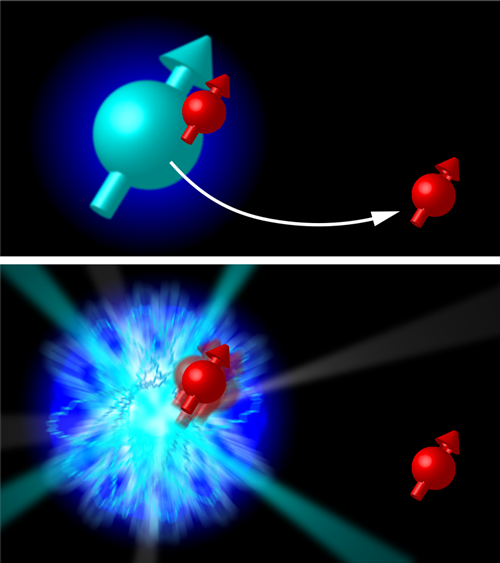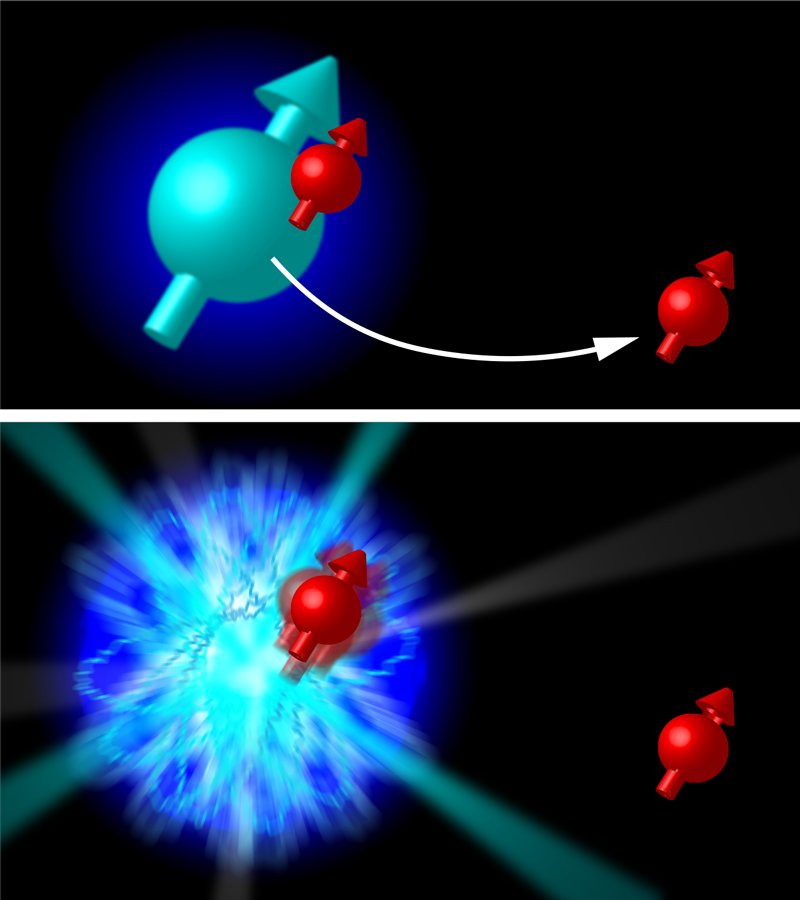Hiding a Quantum Cache in Diamonds
Quantum devices can team up to perform a task collectively, but only if they share that most “spooky” of all quantum phenomena: entanglement. Remote devices have been successfully entangled in order to investigate entanglement itself [1], but the entanglement’s quality is too low for practical applications. The solution, known as entanglement purification [2], has seemed daunting to implement in a real device. Now new research [3] shows that even quite simple quantum components—nanostructures in diamond—have the potential to store and upgrade entanglement. The result relies on hiding information in almost-inaccessible nuclear memories, and may be a key step toward the era of practical quantum networks.
The concept of an interlinked network is absolutely fundamental to conventional technologies. It applies not only to distributed systems like the internet, but also to individual devices like laptops, which contain a hierarchy of interlinked components. For quantum technologies to fulfill their potential, we will want them to have the flexibility and scalability that come from embracing the network paradigm.
Linking together different quantum devices means creating entanglement between their components. While this has been achieved in several systems [1, 4, 5], the quality of the entanglement—its fidelity—is presently too low for practical applications. Fidelity can be thought of as the probability that a particle pair you think is entangled is actually entangled. For example, the system used to generate entanglement may be imperfect: when it indicates a success, there may be only an 80% chance that an entangled pair has actually been created. You could measure the pair to check, but then the entanglement—if it’s there—will be destroyed. Low fidelity like this can, in principle, be improved: entanglement purification involves creating several purported entangled particles between two devices, and then mingling them together using quantum operations within each device. By measuring all but one of the pairs, you can obtain information about the entanglement of the unmeasured pair. If those measurements give the desired results, you can be more certain that the undisturbed pair is indeed entangled [2].
Theoretically, this distilling process can boost fidelity, but so far the purification of entanglement between remote devices hasn’t been experimentally realized. One of the main challenges has been to hold on to a previously generated entangled pair while the next one is created.
Andreas Reiserer from Delft University of Technology in the Netherlands and his colleagues explore entanglement purification in a particularly simple quantum system: a naturally occurring impurity in diamond called the nitrogen-vacancy (NV) center. Each NV center is a nitrogen atom bound to a void in the otherwise endlessly repeating carbon lattice of diamond. Most of the carbons in diamond are carbon-12 isotopes, which have zero nuclear spin. This zero-spin environment allows researchers to individually manipulate (with fields and pulses) the NV center’s electronic spin, the nuclear spin of the nitrogen atom, and the nuclear spins of a few nearby carbon-13 atoms randomly located among the carbon-12 majority. All of these spins can be treated as qubits, and it is possible to transfer information—as well as entanglement—between them.
Creating entanglement between two NV centers involves optically exciting their electrons so that they emit photons and then interfering those photons so that the states of the electrons are entangled. The process is prone to failure (for example, photons are often lost before they reach the interferometer) and many attempts must be made before the respective electron spins become entangled. The Delft team has previously achieved this entanglement in a series of experiments culminating in a fundamental test of quantum physics (a Bell test; see 16 December 2015 Viewpoint) [1]. But now they want to store the entangled pair while another is generated—the core requirement for purification. One might think of transferring the electronic entanglement to nearby nuclear spins so that the electrons are free to create new entanglement. But on the nanometer scale of the NV center, optically exciting an electron is a catastrophically disruptive event: the local fields created during the reset process are such that any information stored on a nearby nucleus would soon become hopelessly corrupted (see Fig. 1). Thus it might seem that NV centers, nature’s prebuilt quantum processors, are simply incompatible with purification.
The team’s proposed solution is to hide the entanglement further afield. They had previously mastered the art of controlling carbon-13 nuclei that were several lattice sites away from the NV core [6], far enough that they might almost be mistaken for part of the environment. The team was able to target a particular carbon-13 nucleus in the NV center’s environment by tuning the repetition frequency of a microwave pulse. These microwaves induce the electron spin associated with the NV center to flip back and forth, and this flipping generates a rotation of the targeted nucleus. The strength of this interaction depends on the distance between the NV center and the nucleus. For the purpose of entanglement purification, one could select a carbon-13 nucleus that is far from the NV core but also well separated from other cabon-13 nuclei, so that the frequency required to address it is unique. Once entanglement is generated in the NV center’s electron, it can be safely moved away to this distant nucleus (or nuclei), and then the turbulent process of creating a second entangled pair can begin.
In this new study, the team assessed the practicality of their idea using just one NV center: they prepared a single qubit (a proxy for one half of an entangled pair) on a distant nuclear spin, then drove the NV center’s electron through a number of excitation cycles with optical laser pulses to simulate repeated efforts at generating new entanglement. Finally they tested to see whether the remote qubit state had been corrupted. In this way they were able to determine how many entanglement attempts could safely take place before significant corruption. The answer was encouraging: hundreds of cycles were tolerable, and with the additional trick of using two remote nuclei to jointly store the qubit, the cycle count rose beyond a thousand. With these numbers, it is realistic to assume that a new entangled pair can be created before the old one is lost.
This is a green light for the Delft team and other leading NV center researchers to build an entanglement purification system. But simultaneously, rival systems are being developed to do the same thing. Ion trap devices are an artificial analog of the NV center, where the atoms are held in a vacuum using arrays of electrodes. The UK’s NQIT quantum technology Hub [7] is a $50-million effort to create optically linked ion traps, and one of the project’s core goals is to develop entanglement purification between separate traps. Its approach is a variant of the modular universal scalable ion trap quantum-computer (MUSIQC) program [8], which is also working to realize practical quantum links. Entanglement purification is also being studied for potential superconducting qubit networks, which would be linked through microwave rather than optical photons [5].
But crucially this isn’t a winner-takes-all race. On the contrary, entanglement purification and other interface technologies such as frequency conversion will make it possible to connect disparate devices into a heterogeneous network. Then each component plays a role according to the advantages of its particular physics: NV centers could work as processors or sensors, while memory might be housed in ion traps or superconductors. In this way we can hope to create an ecosystem of quantum devices that mirrors the flexibility of conventional information technology while tackling tasks that lie beyond its reach.
This research is published in Physical Review X.
References
- B. Hensen et al., “Loophole-Free Bell Inequality Violation Using Electron Spins Separated by 1.3 kilometres,” Nature 526, 682 (2015); “Loophole-Free Bell Test Using Electron Spins in Diamond: Second Experiment and Additional Analysis,” arXiv:1603.05705.
- C. H. Bennett, G. Brassard, S. Popescu, B. Schumacher, J. A. Smolin, and W. K. Wootters, “Purification of Noisy Entanglement and Faithful Teleportation via Noisy Channels,” Phys. Rev. Lett. 76, 722 (1996).
- A. Reiserer, N. Kalb, M. S. Blok, K. J. M. van Bemmelen, T. H. Taminiau, R. Hanson, D. J. Twitchen, and M. Markham, “Robust Quantum-Network Memory Using Decoherence-Protected Subspaces of Nuclear Spins,” Phys. Rev. X 6, 021040 (2016).
- D. Hucul, I. V. Inlek, G. Vittorini, C. Crocker, S. Debnath, S. M. Clark, and C. Monroe, “Modular Entanglement of Atomic Qubits Using Photons and Phonons,” Nature Phys. 11, 37 (2014).
- A. Narla et al., “Robust Concurrent Remote Entanglement between Two Superconducting Qubits,” arXiv:1603.03742.
- T. H. Taminiau, J. Cramer, T. van der Sar, V. V. Dobrovitski, and R. Hanson, “Universal Control and Error Correction in Multi-Qubit Spin Registers in Diamond,” Nature Nanotech. 9, 171 (2014).
- See NQIT.org; the design is as described in R. Nigmatullin, C. J. Ballance, N. de Beaudrap, and S. C. Benjamin, “Minimally Complex Ion Traps as Modules for Quantum Communication and Computing,” arXiv:1605.00111.
- C. Monroe, R. Raussendorf, A. Ruthven, K. R. Brown, P. Maunz, L.-M. Duan, and J. Kim, “Large-Scale Modular Quantum-Computer Architecture with Atomic Memory and Photonic Interconnects,” Phys. Rev. A 89, 022317 (2014).





